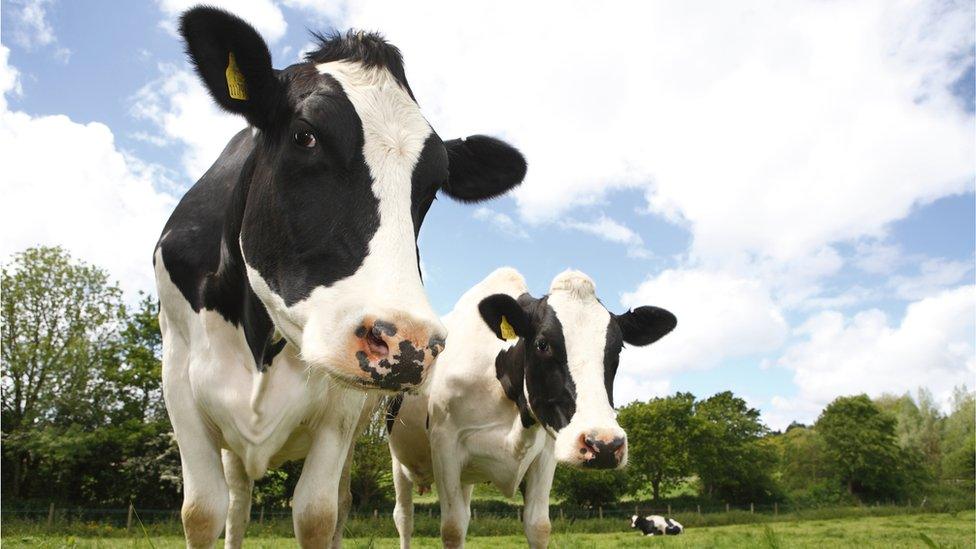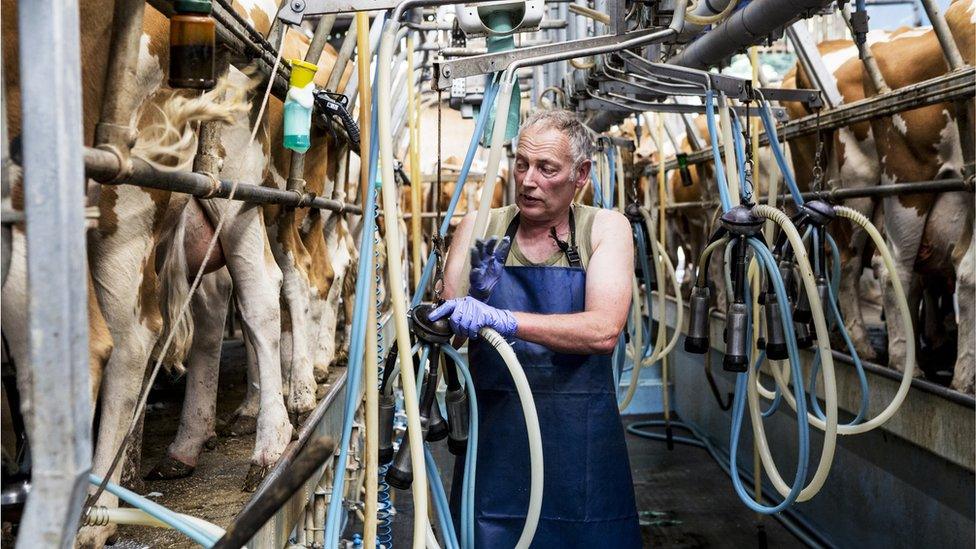Dairy farmers set target to boost cheese and milk values
- Published

Dairy farms have been shutting down during a long period of low prices and battles with retailers
Scotland's dairy farmers and their bovine workforce have been set a new target to boost the industry's economic value from £800m a year to £1.4bn.
The published plan, external to get there by 2030 has been drawn up by leading groups in the industry.
It says successes in creating premium cheese brands should be followed up and new export markets pursued.
The plan also seeks to address the problem of cows producing methane, and the effect that has on climate change.
There are targets for fresh milk for hotter countries where dairy farming conditions are poor, with powdered milk to supply Asia.
The dairy sector has seen a prolonged period of low prices and battles with retailers.
The closure of cafes in the past year has taken away a large part of the market, and non-dairy forms of milk, including soya, almond and oat, have become significant competitors.
Herd sizes up
Dairy farms have been shutting down and herds have had to get bigger to be viable. Last year alone, more than 46 farmers left the sector while 10 joined it, leaving 843 herds across Scotland by the end of 2020.
That is reckoned to be down by 7,000 herds in the past 50 years and average herd size has crept up, now at 209 cows.
The biggest fall last year was in Aberdeenshire, where more than half the 26 dairy farmers left the sector. This followed dairy giant Muller ceasing to buy from 14 farmers after it reviewed its Scottish operations.
The vision document for the industry, titled Rising to the Top, describes major problems with investment in processing. Many farmers depend on multinational firms to buy their produce, and have struggled to secure a commitment to expansion.
"We are seeing major investment in existing plants helping to drive efficiency into operations and supply chains," says the blueprint. "However, the challenge of attracting inward investment in processing continues to hamper our ability to produce added value dairy products in formats and volumes that world markets are demanding."
There is, for instance, no capacity for making milk powder or Ultra-Heat Treated milk, for longer shelf-life.

The report goes on to take an upbeat approach to targeting premium cheese markets, noting that 15 new overseas markets have been opened up, with annual sales of £30m.
Examples are given such as Isle of Kintyre. Its makers invested not only in new capacity for cheese-making but in overseas visits to open up markets in France, Sweden and Japan.
Seriously Strong cheddar, made in Stranraer, has become one of Britain's leading cheddar brands, and the dairy's owner, Lactalis, has created a new brand, Old Edinburgh, to enter export markets. It is now sold through Costco in the USA.
Lactalis has taken its top brand, President - best known for its brie - and is selling three versions of President Cheddar made at the Galloway creamery.
Food tourism
One of the more innovative firms in the sector is Graham's The Family Dairy, based in Bridge of Allan. It has started production of branded protein yoghurts and milk, Skyr, Quark and Goodness ice-cream.
The report proposes a "Scottish cheeseboard" as a standard offering in Scottish restaurants, accompanied by branded Scottish butter. It suggests dairy products should be paired in the food tourism sector with whisky, beer, berries and salmon.
The growth ambition is for £200m of new sales of Scottish cheeses by the end of this decade, with £150m in new product development, such as powdered milk, and £150m from fresh milk exports.
Scottish dairy in numbers:
843 herds
176,334 cows
65% of herds are in the south-west
Milk production is worth £377m
£415m turnover of manufactured products in 2018
£1.1bn spent on dairy products in Scotland in 2020
41% of Scottish milk goes to drinking and 38% is used for cheese
18% goes south to England and Wales
5 processors account for 94% of milk collection